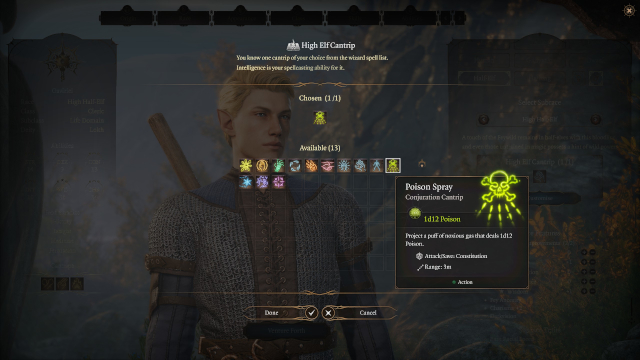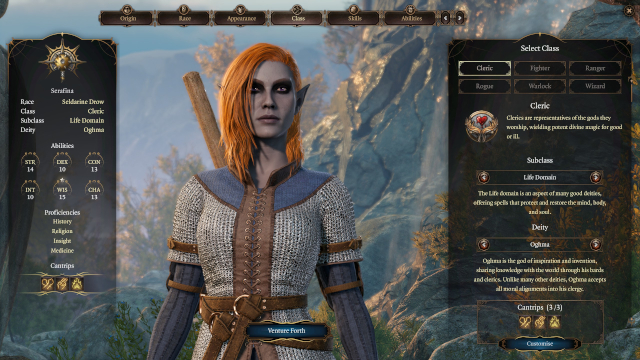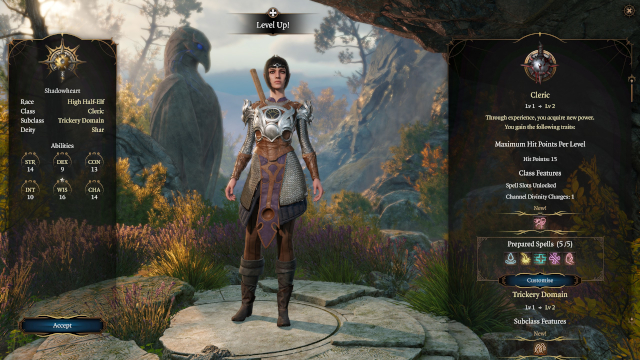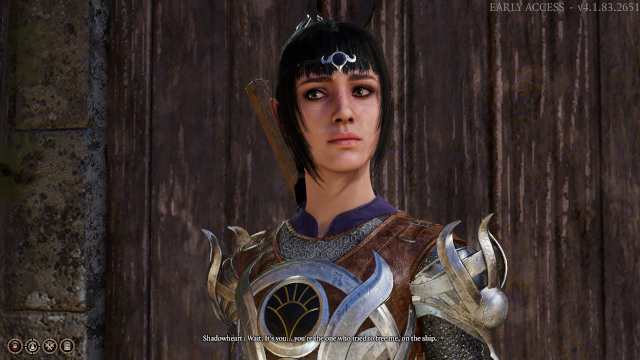The Cleric is the pinnacle of any great adventuring party, but what type of Baldur’s Gate 3 Cleric best complements your party’s playstyle? A diverse selection of Deities and Subclasses pulled straight out of the Dungeons & Dragons Player’s Handbook means that your Cleric can be anything from a steel-clad Mary Poppins to literally the worst person ever. Regardless of which Cleric you’d like to create, everything you need to know about the best Baldur’s Gate 3 Cleric build is covered below!
Baldur’s Gate 3 Best Cleric Build Guide
Character builds in Baldur’s Gate 3 boil down to a selection of:
- Race/Subrace
- Class/Subclass
- Origin
- Skills
- Abilities
- Feats
Depending on your exact character, a build can also include other things like Cantrips and Spells or specific class features. In the Cleric’s case, you must also choose a specific Deity from Dungeons & Dragons lore for your character to worship. This decision impacts whether others in the world see them as “Good,” “Evil,” or something in-between.
There are several different approaches to building a great Cleric in Baldur’s Gate 3, however. You’re encouraged to build the character you’d most like to roleplay in BG3, so if you follow this guide as a loose framework, you should find it much easier to create the Cleric that fits your needs.
Baldur’s Gate 3 Cleric Starting Class Features
- 8 Hit Points + Constitution modifier
- 3 Cleric Cantrips
- 4 Prepared Cleric Spells
- Cleric Spell Slots
- Wisdom Saving Throw Proficiency
- Charisma Saving Throw Proficiency
- Light Armour Proficiency
- Medium Armor Proficiency
- Shield Proficiency
- Simple Weapon Proficiency
Best Cleric Races
Between the eight “base” races, there are actually 16 subraces in Baldur’s Gate 3. Race is an important decision because it permanently impacts your character’s stats, and certain races come with swanky features like Darkvision and built-in skill proficiencies. Of course, there’s also a roleplaying implication to your choice of race, which can change the outcomes of various quests and dialogues throughout Faerûn.
The Cleric’s primary stat is Wisdom, but its saving throws are based on Wisdom and Charisma. As is explained below, your primary stat does indeed influence your race selection, but as I’ll say several times throughout this guide, feel free to create any race/class configuration if it seems interesting to you.
Wisdom influences the Cleric’s ability to cast spells. It also influences their saving throw and their aptitude at Wisdom-based skill checks. The following races offer the greatest starting bonus to Wisdom:
- Wood Elf (+1)
- Human (+1)
- Half-Elf (+1 when allocated)
- Gold Dwarf (+1)
Charisma also influences the Cleric’s saving throw proficiency, as well as how well you’ll roll Charisma-based skill checks. The following races offer the greatest starting bonus to Charisma:
- Tiefling (+2)
- Half-Elf (+2)
- Lightfoot Halfling (+1)
- Drow (+1)
- Human (+1)
I urge you to be mindful of a race’s unique proficiencies and boons. The race with the most relevant stat advantage isn’t always the one you should go with. The following racial features could heavily influence the Cleric you decide to create.
Status Effect Resistance:
- Tieflings get Hellish Resistance, which gives a 50% resistance to all Fire damage.
- All Elf, Drow, and Half-Elf races get Fey Ancestry, which blocks any status affliction that puts your Cleric to Sleep or makes them Charmed.
- Gold Dwarf gets Dwarven Resilience, which grants an advantage to saving throws against Poison, and resists Poison damage.
Skill Proficiencies:
- All Elf subraces get Keen Senses, which grants proficiency in the Perception skill.
- Wood Elf and Wood Half-Elf get Mask of the Wild, which grants proficiency in the Stealth skill.
- Lightfoot Halfling has a bonus called Naturally Stealthy, which grants proficiency to Stealth checks.
Darkvision:
- Many races (Elf, Drow, Half-Elf, Tiefling, Dwarf) get Darkvision, which allows them to see 12 meters ahead in areas with no light.
- Drow gets an even better version, Superior Darkvision, which allows them to see 24 meters ahead in areas with no light.
- Humans, Githyanki, and Halflings lack the highly useful Darkvision feature and need a certain amount of light to see properly.
- Every race but Drow benefits from Darkvision (Spell), which grants 18 meters of vision in the dark but wears off after the spell is broken.
Movement Speed:
- Wood Elf and Wood Half-Elf have an increased movement speed of 10.5m (vs. the standard 9m) per turn.
- Halfling and Dwarf have a decreased movement speed of 7.5m (vs. the standard 9m) per turn.
Miscellaneous Features:
- Gold Dwarf also has Dwarven Toughness, which grants one additional maximum Hit Point per level.
- Lightfoot Halfling also gets Lucky, which forces a reroll whenever you land a die roll of 1. This can be great in tight spots!
Additionally, certain Baldur’s Gate 3 races come with weapon and armor proficiencies, meaning that you can mix and match weapons and armor that your Cleric wouldn’t normally be proficient in. Here are the weapon and armor proficiencies by race:
- Elf: Longsword Proficiency, Shortsword Proficiency, Longbow Proficiency, Shortbow Proficiency.
- Drow: Rapier Proficiency, Shortsword Proficiency, Hand Crossbow Proficiency.
- Githyanki: Light Armor Proficiency, Medium Armor Proficiency, Shortsword Proficiency, Longsword Proficiency, Greatsword Proficiency.
- Gold Dwarf: Battleaxe Proficiency, Handaxe Proficiency, Light Hammer Proficiency, Warhammer Proficiency.
- Shield Dwarf: Battleaxe Proficiency, Handaxe Proficiency, Light Hammer Proficiency, Warhammer Proficiency, Light Armor Proficiency, Medium Armor Proficiency.

Race selection can also give your Baldur’s Gate 3 Cleric a bonus Cantrip, which is basically a spell you can cast whenever you want. Here are the races that give you a bonus Cantrip:
- High Elf & High Half-Elf: Choose between Acid Splash, Blade Ward, Chill Touch, Dancing Lights, Fire Bolt, Friends, Light, Mage Hand, Minor Illusion, Poison Spray, Ray of Frost, Shocking Grasp, or True Strike
- Drow & Drow Half-Elf: Dancing Lights
- Zariel & Asmodeus Tiefling: Thaumaturgy
- Mephistopheles Tiefling: Mage Hand
- Githyanki: Githyanki Psionics: Mage Hand
Baldur’s Gate 3 Cleric Primary Abilities
You can manually allocate your Cleric’s starting abilities out of the following:
- Strength
- Dexterity
- Constitution
- Intelligence
- Wisdom
- Charisma
The Baldur’s Gate 3 Cleric’s saving throws are based on their Wisdom (WIS) and Charisma (CHA) ability, meaning that these are the two most important stats for you to allocate for when you build your Cleric character. Whatever you do, make sure to bulk up your Cleric’s Wisdom score first. Wisdom makes your Baldur’s Gate 3 Cleric an adept spellcaster. That spellcasting ability is central to everything the Cleric does when exploring the world, taking care of fellow party members, and engaging in combat.
With that in mind, Charisma influences your Cleric’s saving throw against certain effects, and it also heavily influences interactions outside of combat, meaning it’s worthwhile to allocate extra points to both Wisdom and Charisma. What about other abilities? Well, Baldur’s Gate 3 is a roleplaying game, which means you should allocate points for whatever role you’d like to play.
You can put points into Intelligence, for example, to get better at logically deducing things in the world around you. Adding points to Strength can make you a better melee fighter and grant you more inventory space to lug your loot around.

Best Cleric Skills
Baldur’s Gate 3 Clerics can pick two skill proficiencies, in addition to any they receive from their race and origin. You’re encouraged to put your Wisdom primary ability to work and start your Baldur’s Gate 3 Cleric with proficiencies in Insight and Medicine. However, you can choose skill proficiencies that seem interesting to the character you’d like to roleplay as instead.
Cleric can become proficient in two skills from the following:
- History (Intelligence)
- Insight (Wisdom)
- Medicine (Wisdom)
- Persuasion (Charisma)
- Religion (Intelligence)
Note: Proficiency equates to an immediate +2 modifier for the skill in question.
Skills automatically receive a +1 modifier for every two points allocated to their corresponding ability, with 10 (+0) as the baseline. Skills also receive a -1 modifier for associated skills whenever a stat decreases to 9 or lower. For example, a Cleric who has 9 points in Strength also has an immediate -1 modifier to Athletics, whereas a Cleric who has 16 points in Dexterity also has an immediate +3 modifier to Stealth.
All Elf characters begin with proficiency in Perception. Wood Elf and Wood Half-Elf characters begin with proficiency in Stealth. Githyanki Clerics can choose up to three skills instead of two. They can even become proficient in skills that are normally unavailable to Clerics.
Best Cleric Backgrounds
Backgrounds are the basic starting point for your Baldur’s Gate 3 Cleric’s background story. Backgrounds also include two additional skill proficiencies.
Though Cleric can’t naturally become proficient in Perception, Animal Handling, and Survival, these useful Wisdom skill proficiencies are unlockable by either choosing Elf as your race, or by picking up the Folk Hero (Animal Handling, Survival), Sailor (Perception), or Outlander (Survival) backgrounds.
Do not choose Urchin or Criminal if you play as Lightfoot Halfling, Wood Elf, or Half-Wood Elf, as you’ll be taking the same Stealth proficiency twice. Likewise, Elf (which gets its own Perception proficiency) shouldn’t take the Sailor background. Otherwise, just like in D&D, choosing your Baldur’s Gate 3 character’s background is all about creating the character you want to roleplay as.

Baldur’s Gate 3 Cleric Subclasses
The choice between Cleric domains is key to what type of character you end up playing as. As of Baldur’s Gate 3‘s Early Access, your Cleric subclass heavily influences the kinds of spells and cantrips you can cast, and it also seems to affect roleplaying options.
Clerics choose their subclass, or Domain, at 1st Level. The three subclasses available to Clerics in Early Access are Life Domain, Light Domain, and Trickery Domain. You must choose a Domain while setting up the rest of your character in the character creation menu. Regardless of subclass, Baldur’s Gate 3 Cleric can choose three of the following Cantrips when starting out:
- Resistance
- Guidance
- Sacred Flame
- Light
- Thaumaturgy
Cleric can also choose three of the following spells when starting out:
- Create Water
- Guiding Bolt
- Shield of Faith
- Bane
- Command (Halt)
- Healing Word
- Inflict Wounds
- Protection from Evil and Good
- Bless
- Cure Wounds
All Clerics receive the Turn Undead action and Channel Divinity feature upon reaching 2nd Level.
Life Domain
Life Domain Clerics are superb healers and are considered “Good” Clerics by the world and its inhabitants. You can tell a Life Domain Cleric apart from the others by the following traits.
- Heavy Armour Proficiency: Wearing Heavy Armour will not impose disadvantage on your attacks or prevent the casting of Spells.
- Disciple of Life: Your devotion empowers your healing Spells. When casting a healing Spell, the target regains additional hit points equal to 2 + the spell’s level.
- Domain Spells: You gain Spells (Bless, Cure Wounds) from your domain. They are always prepared.
- At 2nd Level, Life Domain Clerics receive the Preserve Life action.
- At 3rd Level, Life Domain Clerics learn Lesser Restoration and Aid.
Light Domain
Light Domain Clerics are just a bit more vindictive than their Life Domain cousins. This is the Cleric of justice, who wields the power of holy fire and divine light to do (tons of damage to their foes) and the willful bidding of their Deity. Here’s the special stuff for Baldur’s Gate 3 Light Domain Clerics.
- Warding Flare: Shield yourself with divine light. Use your reaction to impose disadvantage on an attacker, potentially causing their attack to miss.
- Domain Spells: You gain Spells (Faerie Fire, Burning Hands) and a Cantrip (Light) from your domain. They are always prepared.
- At 2nd Level, Light Domain Clerics receive the Radiance of the Dawn action.
- At 3rd Level, Light Domain Clerics learn Darkvision (Spell), Scorching Ray, Aid, and Lesser Restoration.

Trickery Domain
Trickery Domain Clerics aren’t what they first appear. Devout to miscreant Deities, these Clerics tend to come with a few tricks up their sleeve. Tricky puns aside, here’s what comes in the tin.
- Domain Spells: You gain Spells (Charm Person, Disguise Self) from your domain. They are always prepared.
- Blessing of the Trickster: Grant another creature advantage on Stealth checks.
- At 2nd Level, Trickery Domain Clerics gain the Invoke Duplicity action.
- At 3rd Level, Trickery Domain Clerics learn Mirror Image (Domain Spell), Pass without Trace (Domain Spell), Aid, and Lesser Restoration.
Deities
As a Baldur’s Gate 3 Cleric, you must also select a Deity during character creation. You get the option to choose which Deity you support. Each one has a different set of morals and traditions rooted in the world of Faerûn.
Right now, your choice of Deity doesn’t seem to have much of an impact beyond some dialogues. Still, in regular D&D, the Cleric’s chosen Deity is central to their ability to cast spells and do other important things of that nature. The following Deities are available to choose from:
- Bane
- Bhaal
- Corellon Larethian
- Eilistrae
- Garl Glittergold
- Helm
- Ilmater
- Kelemvor
- Laduguer
- Lolth
- Moradin
- Myrkul
- Mystra
- Oghma
- Selune
- Shar
- Tempus
- Tyr
- Vlaakith
- Yondalla
And with that, you’ve learned everything you need to know about the best Cleric build in Baldur’s Gate 3! If you found this build guide useful, please consider sharing it with other players. Stick around with GameSkinny for more Baldur’s Gate 3 tips and strategy guides as we progress deeper into Faerûn.







Published: Aug 4, 2023 02:09 pm